“We are fully satisfied with the way Zendesk is implemented within EBP. The proposed solution has helped us grow our business by providing agents with an easy-to-use platform.”
Grégoire Leclercq
deputy managing director at EBP
2018
Customer since
7.5K
Ticket/mo
1.1K+
Help center articles
15%
CSAT improvement
Founded in 1984, EBP is a multinational software firm that offers accounting, sales management, and payroll solutions for small and medium-size businesses. More than 600,000 companies trust EBP to help collect, centralize, and share their data so they know what is happening with their business in real time. But EBP offers more than reliable software—it closely partners with customers to implement and optimize the EBP solutions they use. This is essential for companies that need to keep ahead of regulatory and operational changes.
Since 2013, EBP has been expanding its international presence and increasing the percentage of revenue it receives from Software as a Service (SaaS) businesses. Currently at 20 percent, its goal is to receive 50 percent of its total revenue from SaaS companies by 2022. To capture and retain market share in this competitive space, EBP has been heavily investing in a more sophisticated customer experience operation.
EBP challenges itself to provide fast, effective, and transparent customer support
One of the major challenges of EBP’s global expansion has been the uptick in support requests, which is especially pronounced during the first quarter of every year, a period that in France is synonymous with taxes, social engagements, and legal deadlines. “EBP received about 6,000 customer emails per month from January to April 2018,” said Marie Amiot, director of customer relations. “It took about three weeks for tickets to be resolved.”
In 2017, its leadership decided to replace the Outlook inbox and Excel spreadsheets that it was using to track and solve customer requests with a more scalable support platform. It was important that a new help desk vendor provide visibility into why customers were reaching out and self-service options so EBP could deflect incoming requests. EBP evaluated BMC Remedy and Zendesk as potential vendors.
“Zendesk was an obvious choice. We knew about its reputation as a powerful and flexible communication platform and wanted to benefit from its experience,” said Grégoire Leclercq, deputy managing director at EBP. “After we saw a demonstration and were able to experience Zendesk’s ease of use, the validity of its reputation was confirmed.“
EBP’s internal IT team implemented Zendesk in 2017 as part of a phased roll-out that allowed employees to keep using existing tools such as Outlook for a limited period of time. The initial deployment across EBP’s customer support department took only a few days.

“We decided to organize a very light project to start,” Leclercq said in an interview with Enterprise Times. “In the past we tried to launch Salesforce and it was a huge project, it was too big, it was a disaster. Therefore we decided to have a short project with a small team, it was very agile.”
Leclercq added in that same interview that he finds Zendesk to be customer centric and intuitive, whereas Salesforce is “too heavy and too big” to stay agile, intuitive, and customer focused.
One of the immediate benefits was that managers no longer had to manually assign tickets to each agent. With Zendesk, tickets are automatically routed, saving both managers and agents valuable time. EBP also started proactively avoiding ticket backlogs by setting up an automation that sends agents notifications when a ticket has been left open for too long.
In subsequent phases, EBP rolled out Zendesk Chat, a dynamic help center powered by Zendesk Guide, and Answer Bot to automatically solve tickets. EBP has seen huge improvements from these investments. “We have incredible statistics for the knowledge base,” Leclercq said in the Enterprise Times interview. “When we launched Guide we had 160 articles and 18 videos. Eleven months later, we had 1,152 articles and 82 videos.”
Leclercq continued explaining that since December 2018, EBP has been getting 150,000 visits to its help center, a figure that far exceeds its inbound call volume, proving that customers have been able to find the content they need to self-serve. Even better, when agents come back to work on Mondays, they see that Answer Bot has been able to respond to and solve a hefty chunk of the weekend’s inquiries.

EBP has been actively using data to get ahead of customer requests. By surveying customers about turnaround times, agent responses, and software implementations, it has been able to gain a level of visibility that was previously impossible. EBP uses this data and Zendesk Content Cues to better understand customers’ behavior, anticipate questions, and create content that proactively addresses customers’ needs. EBP’s CSAT improvement demonstrates that its effort is paying off.
“The steady increase in customer satisfaction speaks for itself,” Leclercq said. “During EBP’s seasonal peak in January and February 2018, 71% of customers were satisfied, while the company processed 15,000 emails and tickets over the same period. Six months after the launch of Zendesk in June 2018, EBP’s CSAT rose to 82% and 60% of tickets were processed in less than 24 hours.”
Another impactful project was using the Zendesk API to build an integration between Zendesk Support and EBP’s accounting software, which enables the company to access Zendesk ticket details from within its own software solution, saving employees time accessing customer context and helping ensure customers do not need to repeat themselves when they reach out.
EBP plans to build on the progress it’s made by deploying an interactive knowledge base to centralize internal content for EBP employees. It is also redesigning its website to make sure help is available 24 hours a day, seven days a week.
“We want to optimize how we are able to build relationships with our customers. In addition to the knowledge base and ticketing system, we want to integrate phone support so we can provide customers a true omnichannel experience,” Leclercq said. “That would be the final touch to deliver outstanding support.
